Study on Strain Field Evolution of Uniaxial Compression Sandstone Based on Digital Image Correlation Technology
Abstract
:1. Introduction
2. Materials and Methods
2.1. Sample Preparation
2.2. Test Equipment
2.3. Test Method and Scheme
2.3.1. Explanation on the Test of Different Loading Rate
2.3.2. Explanation on the Test with Different Grain Sizes
2.3.3. Explanation on the Test with Different Prefabricated Cracks
3. Test Results and Analysis
3.1. Evolution of Strain Field of Sandstone under Different Loading Rates
3.2. Strain Field Evolution of Sandstone with Different Grain Sizes
3.3. Strain Field Evolution of Sandstone with Different Prefabricated Fractures
4. Conclusions
- (1)
- With the increase in loading rate, the time for the growth of cracks inside the sandstone is no longer enough; thus, the peak strength and elastic modulus of the rock under uniaxial compression will gradually increase.
- (2)
- The increase in grain size will result in the decrease of homogeneity and uniformity of sandstone, which will further lead to the decrease in its peak strength, elastic modulus and density. Under the same stress conditions, fine-grained sandstone, compared with coarse-grained sandstone, will undergo a longer elastic deformation stage.
- (3)
- Although sandstone with prefabricated fracture subjected to uniaxial compression will undergo shear failure, tensile strain can also be observed near the crack tip. This means, essentially, that the failure of rock is tensile, and that shear is caused by the displacement of the tensile failure parts of the rock.
Author Contributions
Funding
Institutional Review Board Statement
Informed Consent Statement
Data Availability Statement
Conflicts of Interest
References
- Li, P. Study on Failure Mechanism and Stabilily Control of Surrounding Rock of Underground Openings in Jointed Rockmass under Static and Dynamic Loading. Ph.D. Thesis, Univercity of Science and Technology Beijing, Beijing, China, 2020. [Google Scholar]
- Pandouria, A.K.; Kumar, S.; Tiwari, V. Experimental study of dynamic fracture behavior of Al7075-T651 under different loading rates. Mater. Today Commun. 2022, 33, 104529. [Google Scholar] [CrossRef]
- Khan, N.M.; Ma, L.; Cao, K.; Spearing, A.J.S.; Liu, W.; Jie, Y.; Yousaf, M. Early Violent Failure Precursor Prediction Based on Infrared Radiation Characteristics for Coal Specimens under Different Loading Rates. Rock Mech. Rock Eng. 2022, 55, 6939–6961. [Google Scholar] [CrossRef]
- Wang, J.B.; Zhang, Q.; Song, Z.P.; Zhang, Y.W.; Liu, X.R. Mechanical properties and damage constitutive model for uniaxial compression of salt rock at different loading rates. Int. J. Damage Mech. 2021, 30, 739–763. [Google Scholar] [CrossRef]
- Zhao, R.; Tao, M.; Wu, C.; Li, X.; Wang, S. Study on size and load rate effect of dynamic fragmentation and mechanical properties of marble sphere. Eng. Fail. Anal. 2022, 142, 106814. [Google Scholar]
- Zhou, L.; Zhu, Z.; Qiu, H.; Zhang, X.; Lang, L. Study of the effect of loading rates on crack propagation velocity and rock fracture toughness using cracked tunnel specimens. Int. J. Rock Mech. Min. Sci. 2018, 112, 25–34. [Google Scholar] [CrossRef]
- Cao, A.; Jing, G.; Ding, Y.L.; Liu, S. Mining-induced static and dynamic loading rate effect on rock damage and acoustic emission characteristic under uniaxial compression. Saf. Sci. 2019, 116, 86–96. [Google Scholar] [CrossRef]
- Potyondy, D.O.; Cundall, P.A. A bonded-particle model for rock. Int. J. Rock Mech. Min. Sci. 2004, 41, 1329–1364. [Google Scholar] [CrossRef]
- Lindqvist, M.; Evertsson, M.; Chenje, T.; Radziszewski, P. Influence of particle size on wear rate in compressive crushing. Miner. Eng. 2006, 19, 1328–1335. [Google Scholar] [CrossRef]
- Wang, X.; Wang, Y.; Liao, C.; Cui, J.; Shen, J.H.; Wang, X.Z.; Zhu, C.Q. Particle breakage mechanism and particle shape evolution of calcareous sand under impact loading. Bull. Eng. Geol. Environ. 2022, 81, 372. [Google Scholar] [CrossRef]
- Li, M.; Zhang, J.; Guo, Y.; Pu, H.; Peng, Y. Influence of particle size distribution on fractal characteristics of waste rock backfill materials under compression. J. Mater. Res. Technol. 2022, 20, 2977–2989. [Google Scholar] [CrossRef]
- Liu, X. Study on the Mechanical Behavior and Failure Mechanism of Fissured Rock under Triaxial Compression. Ph.D. Thesis, China University of Mining and Technology, Xuzhou, China, 2020. [Google Scholar]
- Brace, W.F.; Bombolakis, E.G. A Note on Brittle Crack Growth in Compression. J. Geophys. Res. 1963, 68, 3709–3713. [Google Scholar] [CrossRef]
- Hoek, E.; Bieniawski, Z.T. Brittle fracture propagation in rock under compression. Int. J. Fract. Mech. 1965, 1, 137–155. [Google Scholar] [CrossRef]
- Lajtai, E.Z. Brittle-Fracture in Compression. Int. J. Fract. 1974, 10, 525–536. [Google Scholar] [CrossRef]
- Lajtai, E.Z. Strength of discontinuous rocks in direct shear. Geotechnique 1969, 19, 218–233. [Google Scholar] [CrossRef]
- Bertram, B.K. Cracks and Fracture. s. l.; Academic Press: Cambridge, MA, USA, 1999. [Google Scholar]
- Lin, P.; Wang, R.H.C.; Wang, R.K.; Zhou, W.Y. Crack growth mechanism and failure behavior of specimen containing single flaw with different angles. Chin. J. Rock Mech. Eng. 2005, 24 (Suppl. 2), 5652–5657. [Google Scholar]
- Scholz, C.H. Experimental study of the fracturing process in brittle rocks. J. Geophys. Res. 1968, 73, 1447–1454. [Google Scholar] [CrossRef]
- Mogi, K. Source locations of elastic shocks in the fracturing processes in rocks. Bull. Earthq. Res. Inst. Tokyo Imp. Univ. 1968, 46, 1103–1125. [Google Scholar]
- Kudela, P.; Wandowski, T.; Malinowski, P.; Ostachowicz, W. Application of scanning laser Doppler vibrometry for delamination detection in composite structures. Opt. Lasers Eng. 2017, 99, 46–57. [Google Scholar] [CrossRef]
- Lukasz, S. Quality assurance and control of steel blade production using full non-contact frequency response analysis and 3d laser doppler scanning vibrometry system. In Proceedings of the 11th IEEE International Conference on Intelligent Data Acquisition and Advanced Computing Systems: Technology and Applications, Cracow, Poland, 22–25 September 2021; pp. 419–423. [Google Scholar]
- Sutton, M.A.; Orteu, J.J.; Schreier, H. Image Correlation for Shape, Motion and Deformation Measurements: Basic Concepts, Theory and Applications; Springer Science & Business Media: Columbia, SC, USA, 2009. [Google Scholar]
- Mao, L.T.; Liu, H.Z.; Lei, Y.; Wu, J.C.; Ju, Y.; Chiang, F.P. Evaluation of Global and Local Digital Volume Correlation for Measuring 3D Deformation in Rocks. Rock Mech. Rock Eng. 2021, 54, 4949–4964. [Google Scholar] [CrossRef]
- Mugnai, F.; Caporossi, P.; Mazzanti, P. Exploiting Image Assisted Total Station in Digital Image Correlation (DIC) displacement measurements: Insights from laboratory experiments. Eur. J. Remote Sens. 2022, 55, 115–128. [Google Scholar] [CrossRef]
- Seisuke, O.; Tang, Y.; Xu, J.; Peng, S.J.; Chen, C.C.; Yan, Z.S. Application of 3D-DIC system in rock mechanic test. Rock Soil Mech. 2019, 40, 3263–3273. [Google Scholar]
- Sharafisafa, M.; Shen, L.M.; Xu, Q.F. Characterisation of mechanical behaviour of 3D printed rock-like material with digital image correlation. Int. J. Rock Mech. Min. Sci. 2018, 112, 122–138. [Google Scholar] [CrossRef]
- Zhao, C.; Tian, J.; Hiroshi, M.; Zhao, C.; Bao, C. Crack propagation and damage of rock under uniaxial compression based on global strain field analysis. Chin. J. Rock Mech. Eng. 2015, 34, 763–769. [Google Scholar]
- Wang, X.; Wu, Y.; Cui, J.; Zhu, C.Q.; Wang, X.Z. Shape Characteristics of Coral Sand from the South China Sea. J. Mar. Sci. Eng. 2020, 8, 803. [Google Scholar] [CrossRef]
- Bieniawski, Z.T.; Hawkes, I. International society for rock mechanics commission on standardization of laboratory and field tests suggested methods for determining tensile-strength of rock materials. Int. J. Rock Mech. Min. Sci. 1978, 15, 99–103. [Google Scholar]
- GB/T 23561.1-2009; Methods for Determining the Physical and Mechanical Properties of Coal and Rock—Part 1: General Requirements for Sampling. Standards Press of China: Beijing, China, 2009.
- Pu, C.; Chen, Y.S.; Zhou, C.; LIG, M. Displacement loading rate of rock-like specimenunder uniaxial compress test. J. Water Resour. Archit. Eng. 2018, 16, 161–164. [Google Scholar]
- Zhou, H.; Yang, Y.S.; Xiao, H.B.; Zhang, C.Q.; Fu, Y.P. Research on loading rate effect of tensile strength property of hard brittle marble—Test characteristics and mechanism. Chin. J. Rock Mech. Eng. 2013, 32, 1868–1875. [Google Scholar]

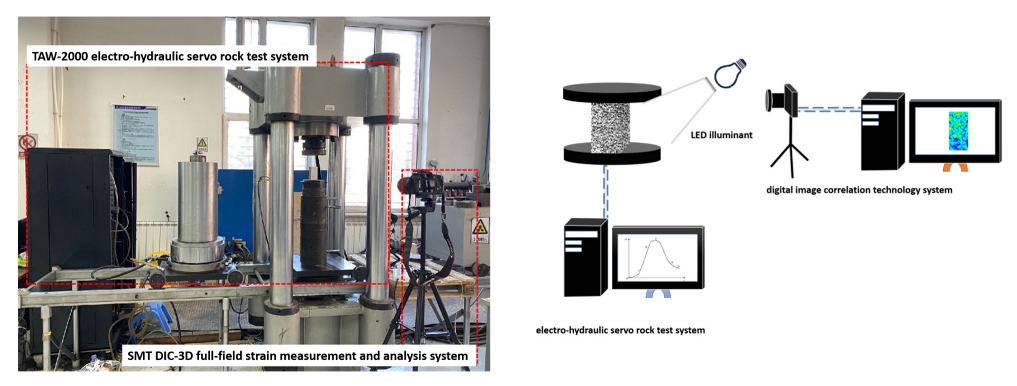
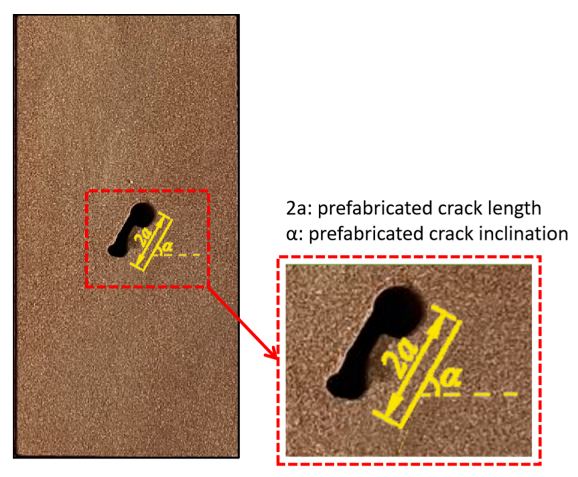

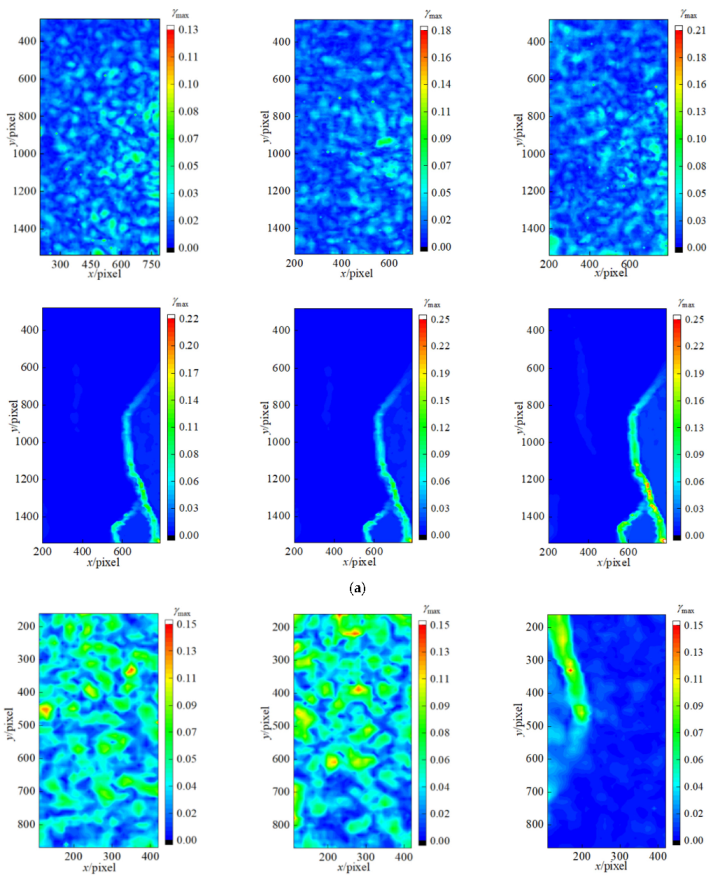

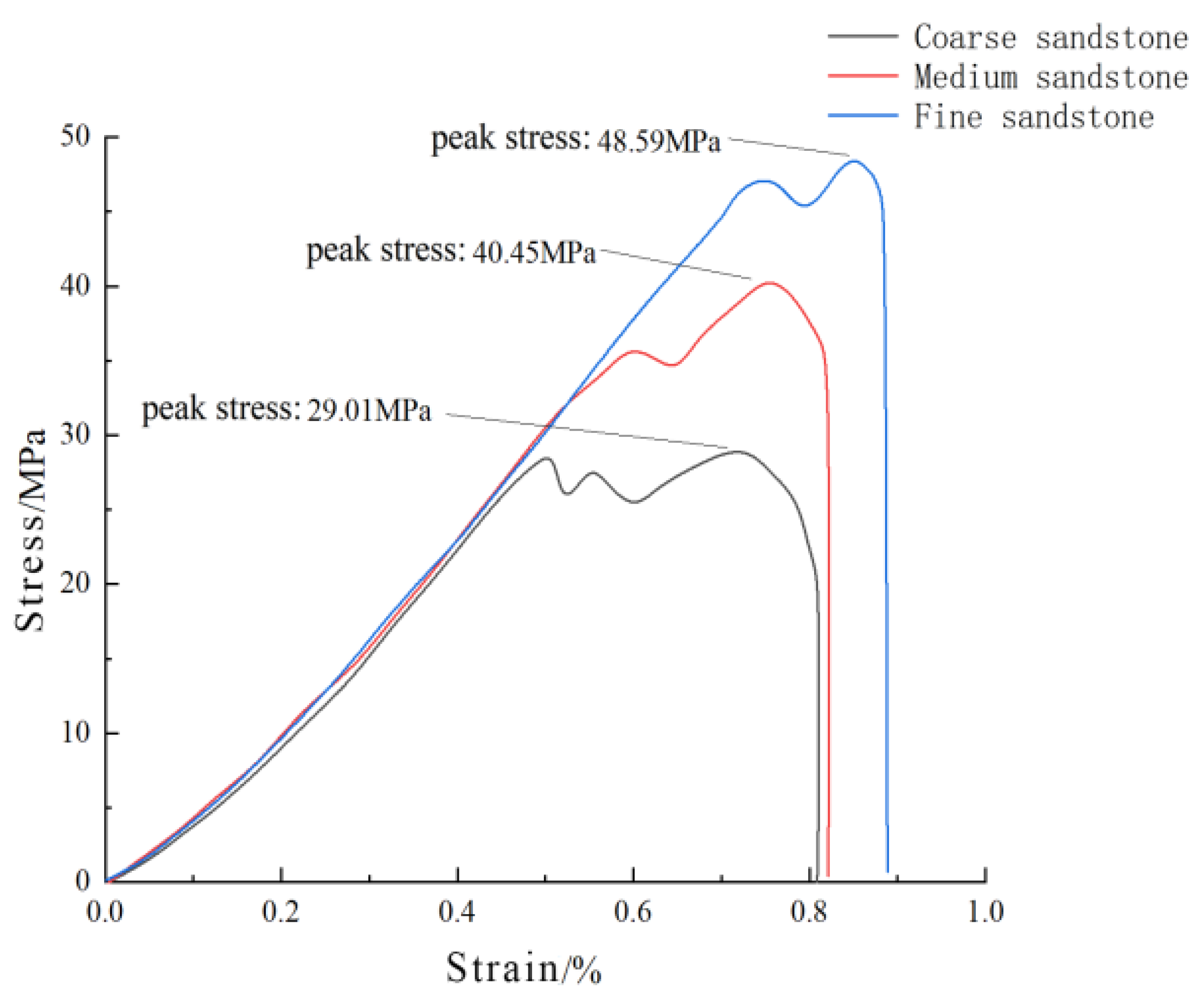
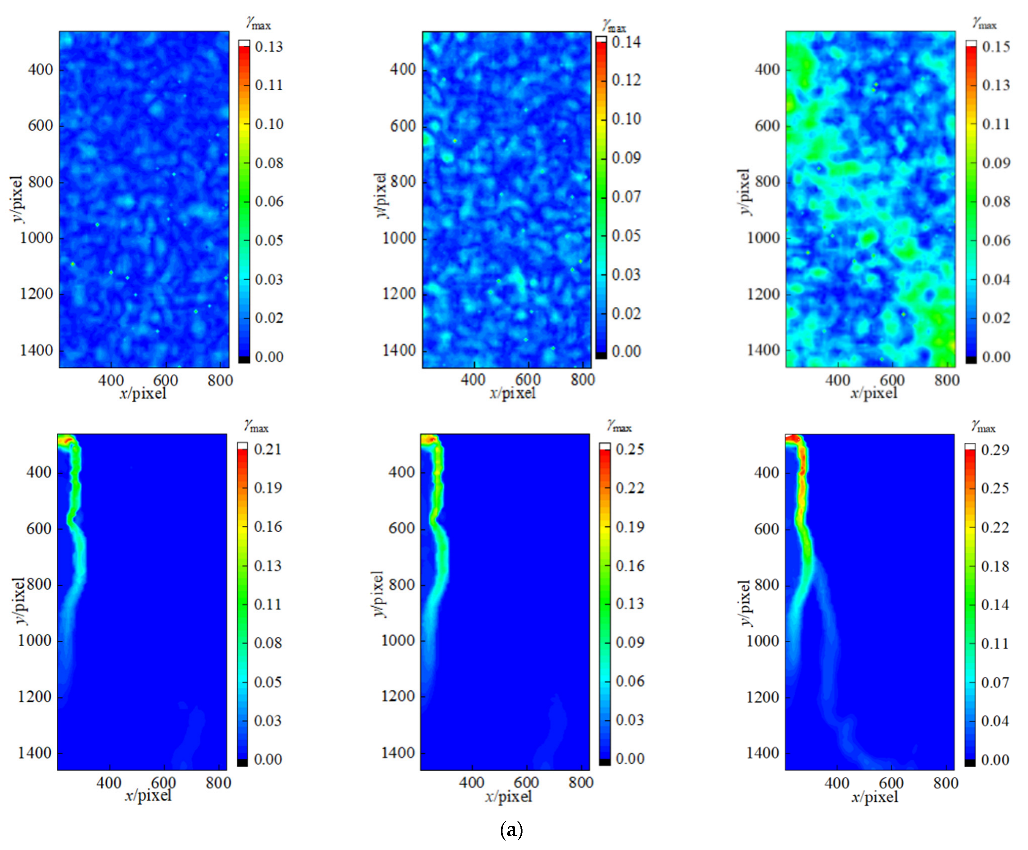
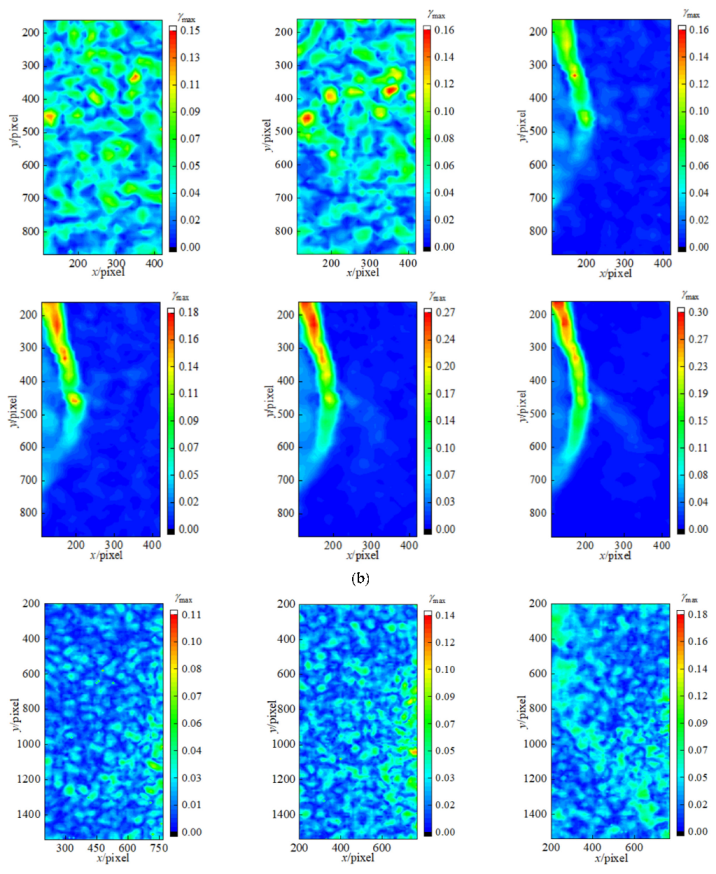
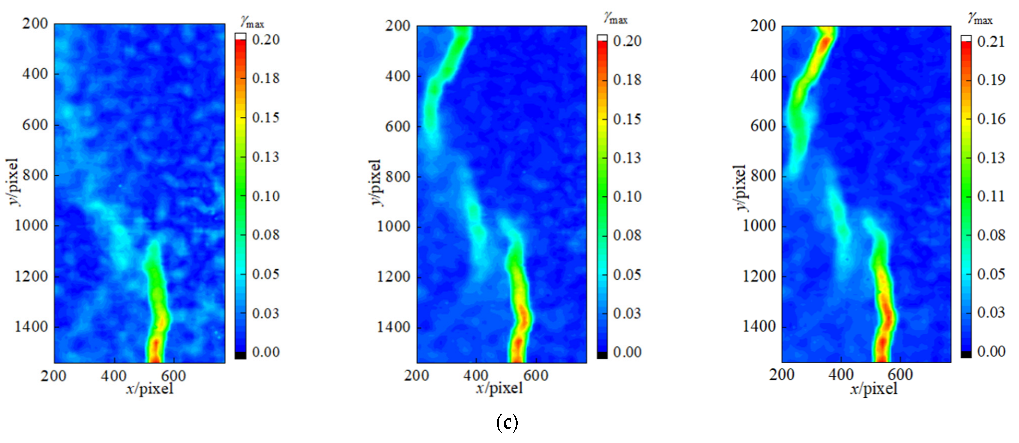
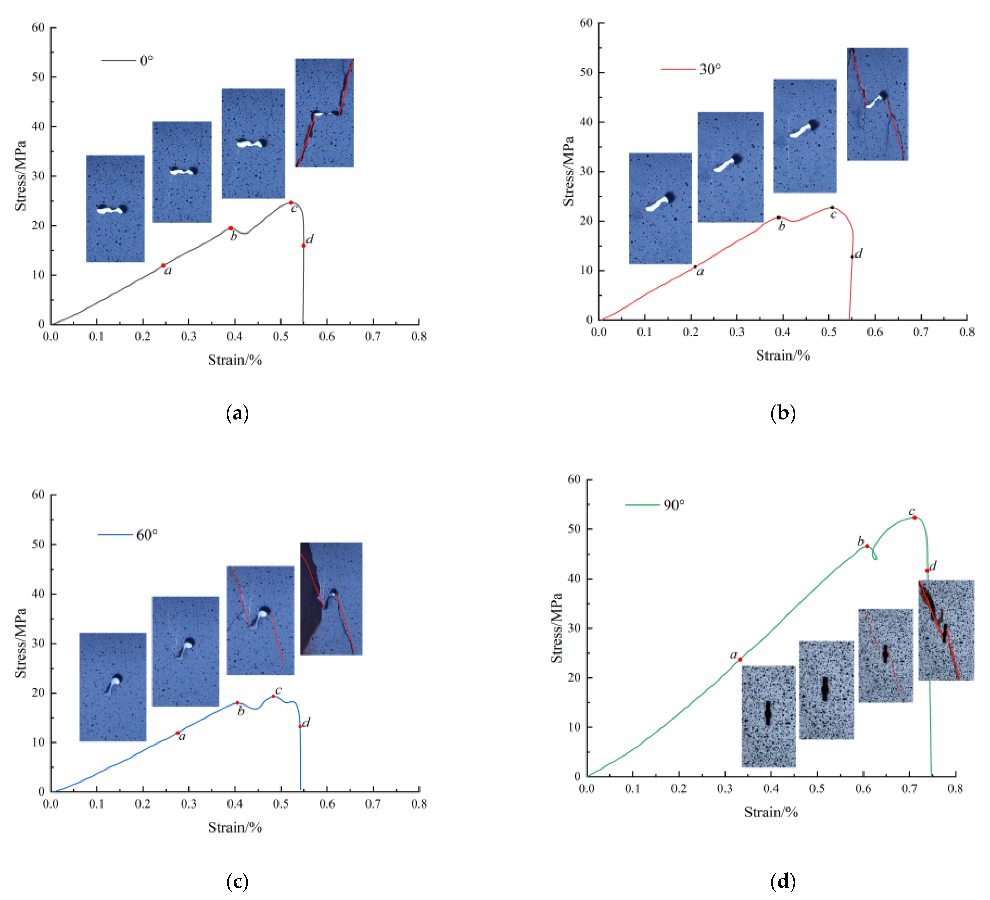
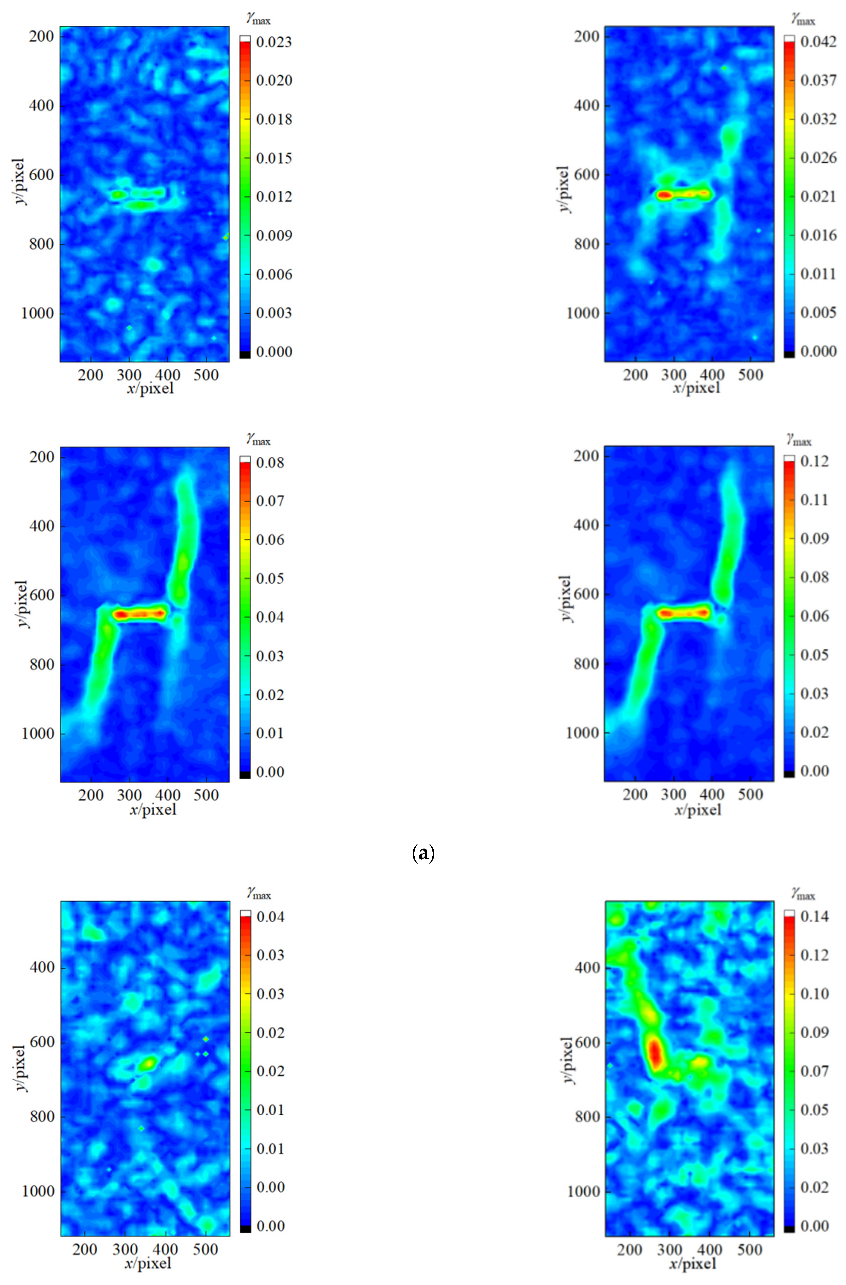
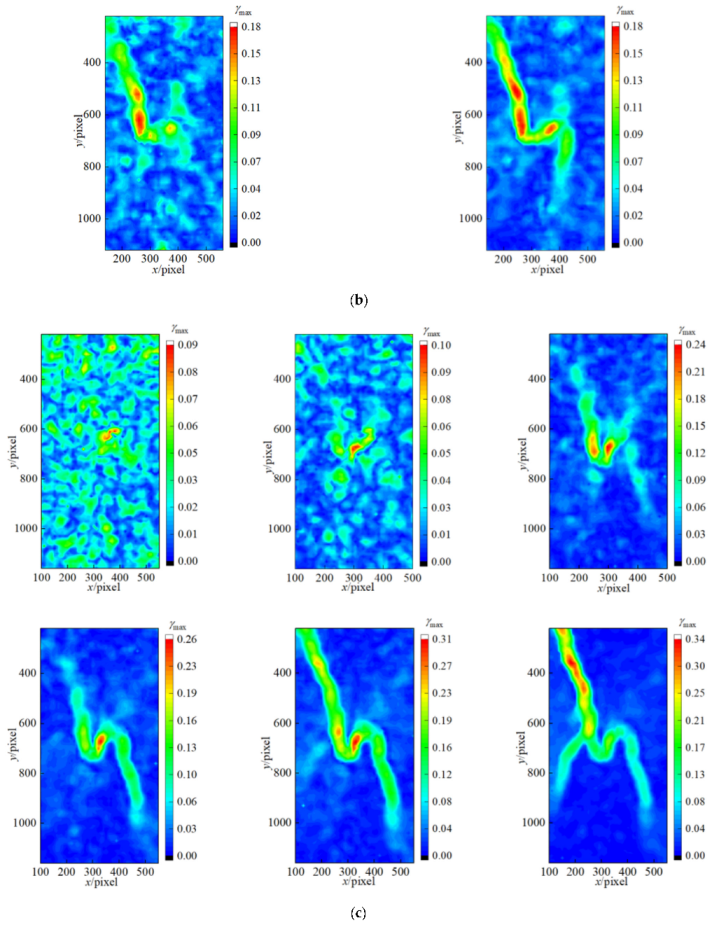

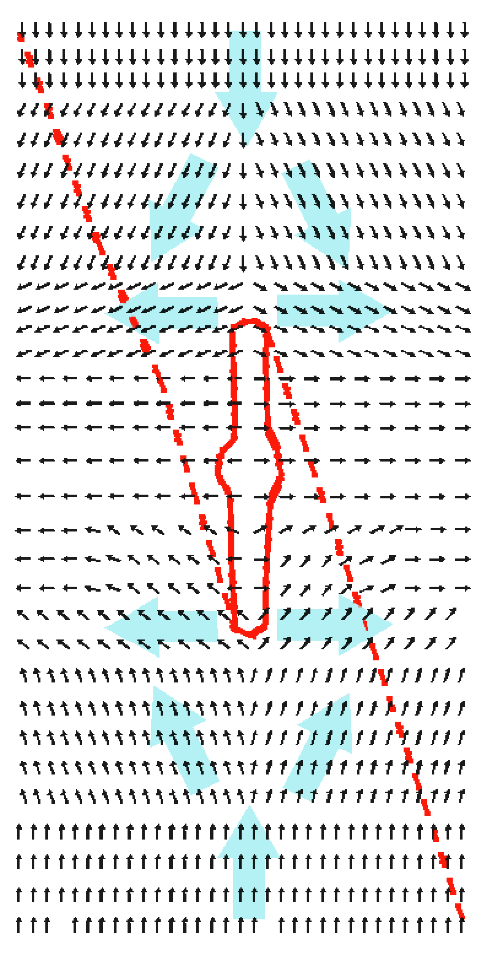
| Test Scheme | Particle Size | Loading Rate | Crack Length | Prefabricated Crack Dip Angle |
|---|---|---|---|---|
| Intact rock (Different loading rates) | 0.25~0.50 mm | 0.02 mm/min | / | / |
| 0.1 mm/min | ||||
| 0.5 mm/min | ||||
| Intact rock (Different particle sizes) | 0.05~0.25 mm (fine sandstone) | 0.1 mm/min | / | / |
| 0.25~0.50 mm (medium sandstone) | ||||
| 0.50~2.00 mm (coarse sandstone) | ||||
| Preformed fractured rock (Different inclination angles) | 0.25~0.50 mm | 0.1 mm/min | 12 mm | 0° |
| 30° | ||||
| 60° | ||||
| 90° |
| Rock Sample Number | Loading Rate/(mm/min) | Peak Stress/MPa | Time Required to Reach Peak Stress/s | Stress Growth Rate/(MPa/s) | Elastic Modulus/MPa |
|---|---|---|---|---|---|
| X11 | 0.02 | 21.5 | 1755.46 | 0.0122 | 4025.19 |
| X12 | 0.02 | 23.8 | 1874.88 | 0.0126 | 4103.31 |
| X13 | 0.02 | 24.2 | 1924.33 | 0.126 | 4156.48 |
| X21 | 0.1 | 29.12 | 320.47 | 0.0909 | 4695.43 |
| X22 | 0.1 | 29.37 | 300.24 | 0.0978 | 4876.75 |
| X23 | 0.1 | 30.03 | 350.14 | 0.0858 | 4795.26 |
| X31 | 0.5 | 32.75 | 65.47 | 0.5002 | 4850.14 |
| X32 | 0.5 | 33.03 | 70.56 | 0.4681 | 4890.71 |
| X33 | 0.5 | 35.63 | 80.94 | 0.4402 | 4875.36 |
| Rock Type | Peak Strength/MPa | Elastic Modulus/MPa | Density/(g/cm3) | Failure Time/s |
|---|---|---|---|---|
| Fine sandstone | 48.59 | 5810.67 | 2.49 | 1115.16 |
| Medium sandstone | 40.45 | 5519.10 | 2.16 | 928.58 |
| Coarse sandstone | 29.01 | 5001.72 | 1.85 | 460.44 |
Publisher’s Note: MDPI stays neutral with regard to jurisdictional claims in published maps and institutional affiliations. |
© 2022 by the authors. Licensee MDPI, Basel, Switzerland. This article is an open access article distributed under the terms and conditions of the Creative Commons Attribution (CC BY) license (https://creativecommons.org/licenses/by/4.0/).
Share and Cite
Xin, C.; Yang, Y.; Yang, M.; Liang, P.; Sun, Y.; Shen, H. Study on Strain Field Evolution of Uniaxial Compression Sandstone Based on Digital Image Correlation Technology. Appl. Sci. 2022, 12, 11939. https://doi.org/10.3390/app122311939
Xin C, Yang Y, Yang M, Liang P, Sun Y, Shen H. Study on Strain Field Evolution of Uniaxial Compression Sandstone Based on Digital Image Correlation Technology. Applied Sciences. 2022; 12(23):11939. https://doi.org/10.3390/app122311939
Chicago/Turabian StyleXin, Changhao, Yu Yang, Mengze Yang, Pengfei Liang, Yidan Sun, and Huazhang Shen. 2022. "Study on Strain Field Evolution of Uniaxial Compression Sandstone Based on Digital Image Correlation Technology" Applied Sciences 12, no. 23: 11939. https://doi.org/10.3390/app122311939
APA StyleXin, C., Yang, Y., Yang, M., Liang, P., Sun, Y., & Shen, H. (2022). Study on Strain Field Evolution of Uniaxial Compression Sandstone Based on Digital Image Correlation Technology. Applied Sciences, 12(23), 11939. https://doi.org/10.3390/app122311939






